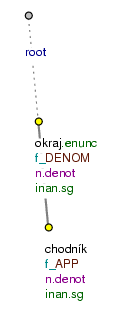The modification with the functor APP is defined semantically. It denotes the appurtenance of one person or thing to another in a very broad sense. The paraphrase "X has Y", where X is the modification with the APP functor and Y is its governing noun. Compare:
-
otec dítěte.
APP(= father of the child)= father has the child, the child belongs to the father.
-
střecha domu.
APP(=lit. the_roof of _the_house)= the house has a roof, the roof belongs to the house.
The modification with the functor APP bears especially the following meanings:
-
expression of kinship (or friendship; also in the metaphorical sense).
Examples:
manžel slavné spisovatelky.
APP(=husband of the famous writer)duchovní otec nové měny.
APP(=the spiritual father of the new currency)její.
APPpříbuzná (=her relative)moji.
APProdiče (=my parents)přítel ministra.
APP(=minister's friend)NB! The free modification with the functor
APPis an obligatory modification in the valency frames of nouns denoting family relationships (and other nouns with a similar meaning). For more on this see Section 2.3.2.4.6, "Valency frames of nouns referring to blood (family) relations". -
expressing the appurtenance of a person to an institution (the name of the person).
Examples:
příslušník armády.
APP(=member of the army)brankář vedoucího týmu.
APP(=the goal-keeper of the leading team)člen výkonného výboru.
APP(=a member of the executive committee)NB! The free modification with the functor
APPis an obligatory modification in valency frames of some nouns denoting the appurtenance. For more on this see also Section 2.3.2.4.6, "Valency frames of nouns referring to blood (family) relations". -
expressing the appurtenance of some people to an institution (the name of the organization).
Examples:
tým brankářů.
APP(=a team of goal-keepers)organizace neslyšících.
APP(=an organization of the hearing-impaired) -
denoting a bearer of a (physical, mathematical) property or quality.
Examples:
míra nezaměstnanosti.
APP(=the unemployment rate)úroveň ubytování.
APP(=the quality of accommodation)průměrnou délku vazby.
APP(=the medium length of the arrest)autorova.
APPupřímnost (=the author's honesty)NB! With some nouns, the bearer of the property/quality is a valency modification. For more on this see Section 2.3.2.4.9, "Valency frames of nouns referring to personal qualities and properties of things".
-
expressing the ownership
Examples:
její.
APPseznam (=her list)má.
APPvyšší postava (=my higher figure)naše.
APPkapela (=our band)dům mého otce.
APP(=my father's house) -
expressing a part-whole relation
Examples:
okraj chodníku.
APP(=the edge of the pavement) Fig. 7.55střecha domu.
APP(=the roof of the house)noha od stolu.
APP(=the leg of the table)vnitřek prodejny.
APP(=the inside of the shop)inzertní oddělení redakce.
APP(=the advertisement department of the redaction)široký pás území.
APP(=wide stripe of land)závěr utkání.
APP(=the end of a match) -
expressing the appurtenance in a very broad sense (with abstract expressions).
Examples:
auto roku.
APP(=the car of the year)poezie lásky.
APP(=love poetry)
Forms. The modification with the functor APP is primarily expressed by a noun in the genitive case or by a possessive adjective.
The basic forms of modifications with the functor APP are:
-
noun in a non-prepositional case form.
The most common forms:
genitive organizace neslyšících (=the organization of the hearing-impaired) -
possessive adjective.
Example:
můj.
APPklobouk (=my hat) -
prepositional phrase.
The most common forms:
k+3 hudba k filmu (=music to the movie); klíč ke schránce (=key to the locker) na+4 obruby na brýle (=lit. frames for glasses) od+2 láhev od šampaňského (=lit. bottle from champagne)
Dependent clause. The modification with the functor APP can be expressed by a dependent clause only with the help of a supporting expression. Example:
Fotografové kříží různé významové roviny toho, co vidíme.APP (=The photographers cross the meaning layers of what we can see)
Borders with the functors AUTH and RSTR. The functor APP borders on the adnominal functors AUTH and RSTR (in cases like: Karlova.APP knížka (=Charles' book) vs. Nezvalovy.AUTH básně (=Nezval's poems)). For details see Section 10.2.1, "Borderline cases with the functor AUTH".
Borders with the functors PAT and ACT. The functor APP in the position of an obligatory free modification borders on the Patient and Actor. For more on this see Section 2.3.2.3.3, "Borderline between the Patient and the MAT and APP functors" and Section 2.3.2.4.9, "Valency frames of nouns referring to personal qualities and properties of things".
Border with the functor MAT. The modification expressing the appurtenance can (when in the genitive form) in some cases border with the meaning of the functor MAT (see Section 10.4, "MAT"). If the governing noun denotes an institution, organization, group etc., the dependent modification is more likely to be assigned the functor APP; the MAT functor is assigned in those cases where the governing noun expresses rather the size of the group (it does not express its character, it only has the meaning of a container). Compare:
-
organizace neslyšících.
APP(=the organization of the hearing-impaired)spolek zahrádkářů.
APP(=the association of gardeners)třída dětí.
APP(=a class of children) -
většina lidí.
MAT(=lit. most of_people)dvojice žen.
MAT(=pairs of women)(velká) skupina dětí.
MAT(=(large) group of children)
Border with the functor ID. The functor APP borders on the functor ID in cases like trest smrti.ID (= death sentence) (explicative genitive). For more on this see Section 8.1, "Basic rules for the annotation of identifying expressions".
